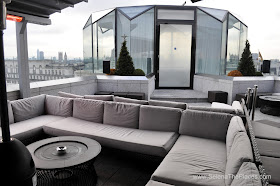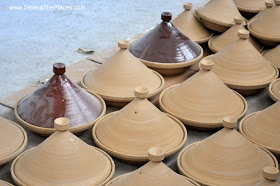When you explore Fès, you will be struck by the handicrafts on display.
In the showrooms, you will find any number of fabulous items; leather, silver, pottery and more.
But take a peak behind the showrooms and you will really be enthralled.
Moroccan artisans have been creating these treasures the same way for hundreds of years.
In this ancient guild society, skills and jobs are passed down from generation to generation.
They are using methods that have been unchanged for centuries.
We visited both a pottery and a tannery during our stay in Fès.
Morocco is well-known for its pottery. We were proudly shown around the workrooms.
We watched the artists handpainting geometric and arabesque designs on dishes of all shapes and sizes.
I so wanted to sit down and join them.
We brought home a miniature Moroccan Tagine which is a Berber cooking vessel with a conical lid.
Many of our wonderful Moroccan meals were served in these.
Isn't she lovely? I asked if I could take her photograph,
she nodded sweetly and then primped for a moment, tucking a stray lock of hair into her scarf.
Tiles are cut down into intricate shapes and then turned into the most beautiful, mosaic fountains.
Fès is particularly famous for creating blue and white pieces using cobalt oxide.
The showroom was full of pieces with beautiful designs influenced by centuries of Islamic culture.
I had read much about the famous tanneries of Fès.
The city once had hundreds of them in the Medina, but now there are only a few left.
In the Leather Souk, you will find one of the oldest tanneries in the world.
In a method that is unchanged since the 11th Century, the hides of goats and sheep
are cleaned and dyed by hand (or foot) without the help of any machinery.
The white stone vessels contain a concoction of water, limestone and acidic pigeon droppings.
The hides are soaked there first to soften them and remove any tissue or hair.
Then they are soaked in the vats of dye and cow's urine to give them distinctive colors.
Traditionally, the tubs would contain natural dyes; indigo for blue, henna for orange or saffron for yellow.
The workers spend hours standing in these liquids, working the hides with their feet.
Chemicals are now sometimes used to the detriment of their health.
The hides are then spread out on the rooftops to dry before being trimmed and sewn into
shoes, coats, bags and foot stools.
The tannery is surrounded by showrooms with terraced balconies.
We were led up into the top of one to watch the work and take photographs.
I had read about the strong odors and that visitors are often given a spring of mint to help them deal with the smell.
It did smell but I don't remember it being that bad.
We were there in April so the weather was mild. It may be worse in the summer.
The leather goods are absolutely beautiful. Rows and rows of shoes!
Unfortunately, my husband is a firm believer in just taking away the experience and sees no need to shop.
(But, honestly, it breaks my heart that I didn't purchase these shoes.)
The tannery was one of the most amazing things I've ever seen.
One more reason to visit this incredible city.
Don't you think I should have purchased some shoes while in Morocco?

































































